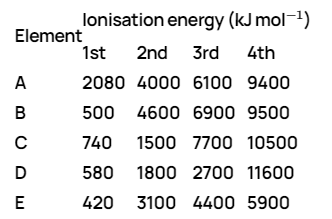Element X forms a chloride with the formula XCl2, which is a solid with a high melting point. X would most likely be in the same group of the Periodic Table as
Na
Mg
AI
Si
To solve the question, we need to analyze the information given about element X and its chloride, XCl₂. Here’s a step-by-step breakdown of the solution:
Step 1: Understand the formula XCl₂
The formula XCl₂ indicates that element X forms a compound with chlorine (Cl) where the ratio of X to Cl is 1:2. This means that for every one atom of X, there are two atoms of chlorine.
Hint: The subscript in the chemical formula indicates how many atoms of each element are present in the compound.
Step 2: Determine the valency of chlorine
Chlorine (Cl) has a valency of -1. This is because it needs to gain one electron to complete its outer shell (octet). Therefore, for every two chlorine atoms (Cl₂), the total negative charge contributed by chlorine is -2.
Hint: The valency of an element indicates how many electrons it can gain or lose when forming compounds.
Step 3: Determine the valency of element X
Since the compound is neutral overall, the positive charge from element X must balance the -2 charge from the two chlorine atoms. Therefore, element X must have a valency of +2. This means that X can lose two electrons.
Hint: The total charge in a neutral compound must equal zero.
Step 4: Identify the group of element X
Elements that have a valency of +2 typically belong to Group 2 of the Periodic Table, which is also known as the alkaline earth metals. Examples of elements in this group include magnesium (Mg) and calcium (Ca).
Hint: Elements in the same group of the Periodic Table often have similar chemical properties and valencies.
Step 5: Conclusion
Based on the analysis, element X would most likely be in the same group as magnesium (Mg), which also has a valency of +2 and forms a chloride with the formula MgCl₂.
Final Answer: Element X would most likely be in the same group of the Periodic Table as magnesium (Mg).
---
The formula XCl₂ indicates that element X forms a compound with chlorine (Cl) where the ratio of X to Cl is 1:2. This means that for every one atom of X, there are two atoms of chlorine.
Chlorine (Cl) has a valency of -1. This is because it needs to gain one electron to complete its outer shell (octet). Therefore, for every two chlorine atoms (Cl₂), the total negative charge contributed by chlorine is -2.
Since the compound is neutral overall, the positive charge from element X must balance the -2 charge from the two chlorine atoms. Therefore, element X must have a valency of +2. This means that X can lose two electrons.
Elements that have a valency of +2 typically belong to Group 2 of the Periodic Table, which is also known as the alkaline earth metals. Examples of elements in this group include magnesium (Mg) and calcium (Ca).
Based on the analysis, element X would most likely be in the same group as magnesium (Mg), which also has a valency of +2 and forms a chloride with the formula MgCl₂.
Topper's Solved these Questions
Similar Questions
Knowledge Check
If element X forms a chloride with the formula XCl3, then X would most likely belong to the same group of the Modern Periodic Table as :
ANaBBrCAlDMgAn element having electronic configuration 2, 8, 18, 3 belongs to which group of the Modern Periodic Table ?
A13th groupB3rd groupC18th groupD15th group
(a) Al is a good reducing agent. Explain.
(b) A metallic element, M, forms two stable chlorides with formula MCl and MCl3 respectively. Where the element M is to be placed in the periodic table ?
View SolutionIn periodic table, melting point/boiling point increases down the group in which of the following group ?
View SolutionAn element X belongs to 3rd period and group II of the periodic table . State :
the valency .
View SolutionName the element which belongs to group 17 and period 2 of the modern periodic table.
View SolutionAn atom of an element X has 2 electrons in its N shell.
Where is this element placed in the periodic table ?
View SolutionIn which of the following group of periodic table melting and boiling point increase as we go down the group?
View Solution

